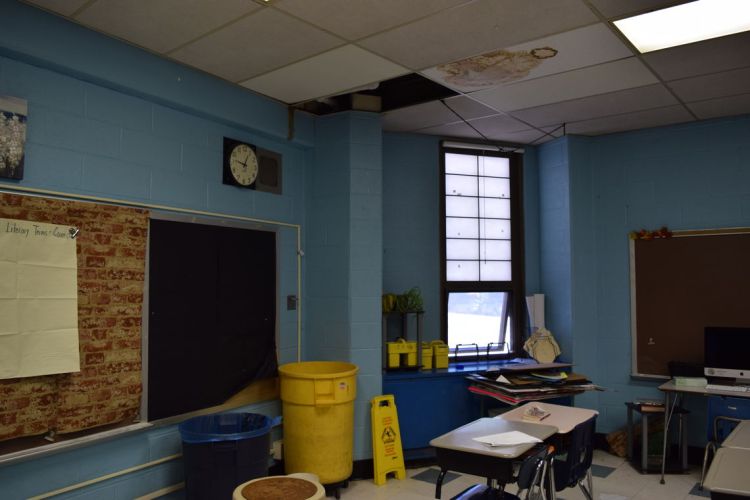Philadelphia public schools have a long history of neglected hazards and deferred maintenance. For many years Philadelphia’s school children have had to exist and try to learn in conditions where the air is contaminated with mold spores, water fountains are lead contaminated, schools are unable to control the internal temperatures, asbestos exposures and rodent infestation issues. Two weeks ago we saw how another district, Monroe County, NJ answered the calls of concerns of parents and staff by closing Holly Glen Elementary for mold remediation in response to high mold results on October 4th. Three days later, and simply as a precaution! all Monroe Township schools were closed for mold inspection and remediation. They remain closed 2 weeks later to allow for a comprehensive assessment to be completed.
In addition, on October 11th, John B. Kelly Elementary school was closed to an emergent mold issue spanning 10 classrooms – for 600 square feet of mold growth. The scope of the mold contamination rapidly expanded to include some 3 dozen areas, and about 1000 feet of mold and impacts on asbestos materials and major ventilation concerns. Only the advocacy and push from educational staff and the teacher’s union prompted district officials to close the Germantown school for immediate remediation. Parents and staff recall the issues with mold at Kelly to be present between 1-2 years. Parents report their children suffer sicknesses, asthma attacks, and upper respiratory infections similar to those reported by parents in Monroe twp.
 Affected room as seen last Spring. The trash cans have been collecting what is leaking from the above pipes. Photo Credit: Greg Windle
Affected room as seen last Spring. The trash cans have been collecting what is leaking from the above pipes. Photo Credit: Greg Windle
There have been similar conditions at many other Philadelphia public schools. So, we have some questions for Philadelphia School District officials. This past summer, Munoz-Marin, Steel, Clemente, and Hunter had extensive mold remediation projects. What about the conditions at Kelly were not deemed bad enough to fix over the Summer, but necessary to close during the school year? How many more schools are in the same condition as Kelly, but have not risen to the level of action by the district? If the conditions at those four schools were also a long standing issue, then why weren’t those schools closed for immediate remediation when the issues were first acknowledged? In addition to mold, our students, teachers, and school staff are exposed to lead in paint and drinking water, asbestos, rodent and pest infestations, and lack of proper climate control within our school buildings.
One thing that parents in Monroe twp have to help them understand the issues at their schools is the actual Indoor Air Quality report for Holly Glen Elementary, which identifies the classrooms, the contamination, and problem analysis. The report includes pictures of the affected areas and damage. In contrast, it is not currently possible for a parent to obtain the Indoor Air Quality test results or report of their child’s school in Philadelphia public. Unfortunately there is an enormous amount of data that is unavailable to an informed public with regard to Philadelphia public schools. The lack of information only leads to more questions:
- How do we know how significant the damage was/is in the district’s schools? We don’t?
- Is the damage here worse than in Monroe Twp schools? We don’t know?
- Are our children at any greater risk by having them continue in school buildings with these conditions? We don’t know.
- What is the district’s plan to avoid the situation in the future? We don’t know.
- Are there any other schools that have similar conditions? We don’t know.
- What were the specific conditions that highlighted the 4 schools for mold remediation and the 5 for asbestos abatement this past Summer? We don’t know.
- Was the work done this Summer done correctly to ensure our children’ health and safety? We don’t know.
- Was the money used to remediate mold and asbestos spent responsibly? We don’t know.
A high level of transparency is essential in getting our children the clean, warm, nurturing classrooms and schools that they deserve. To date, we have not had the level of assistance or transparency from the district that would allow parents to feel that our children are well taken care of in their school buildings.
Sometimes things don’t change is because no one is willing to learn from the problem to make different choices.
We are trying to make a change in the way the school district maintains and improves its school buildings. The Philly Healthy Schools Initiative is working towards: improving the amount of information and data transparency from the district, establishing an adequate building conditions and best practices to ensure a healthy learning environment, identifying and addressing the most critical health and safety priorities, and establishing a stakeholder advisory committee. Our goal is to work with the district to achieve the clean, safe, warm, nurturing environment that the district states as its standard.
We Can & We Must Do Better.
How you can help:
- Parents and teachers collaborate to identify and report facility conditions that are unhealthy and unsafe. Teacher reports to the principal need to be carried up to the union.
- Go into your child’s school. Visit their classrooms, and yes, the bathrooms. Look at the ceiling tiles, walls, flooring. Notice odors, pests and their waste. If there is anything that concerns you, tell the principal. Parents should also make a note of their concerns to make follow up easier.
- Read the Facility Condition Assessment for your child’s school. It can be found on the district website. All schools were assessed in 2015. It gives a snapshot of the school’s condition and a priority list of issues.
- Contact us at parentsunitedphila@gmail.com
- Contact Philly Healthy Schools Initiative for more information. David Masur: davidmasur@pennenvironment.org
